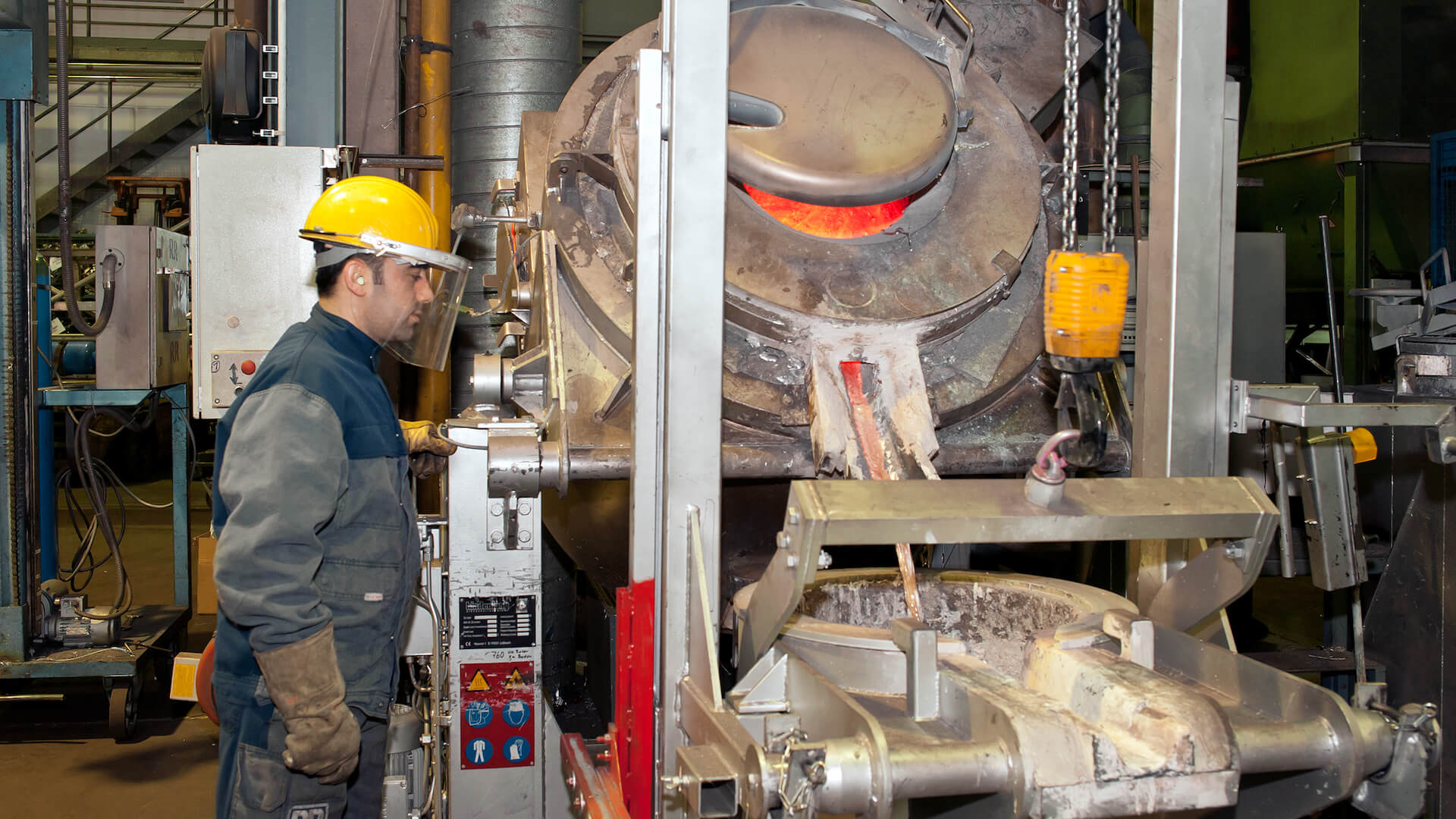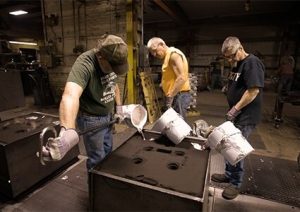Expert Insights on Working with an Aluminum Foundry for Efficient Output
Wiki Article
A Comprehensive Guide to the Benefits of Utilizing Aluminum From Foundries
Aluminum from foundries provides a variety of advantages that make it a useful product throughout numerous markets. Its light-weight nature contributes to cost financial savings in transportation and improves general item effectiveness. In addition, aluminum's exceptional resistance to deterioration assurances durability and minimizes maintenance requirements. Nevertheless, the benefits expand beyond these facets (Wisconsin Aluminum Foundry). Understanding the complete range of aluminum's residential or commercial properties and their implications can disclose even much deeper insights right into its role in modern-day applicationsRecognizing Foundry-Grade Aluminum
Foundry-grade aluminum is a customized product renowned for its outstanding buildings and convenience in numerous applications. This kind of aluminum is commonly produced through managed casting processes, permitting exact control over its composition and microstructure. Consequently, foundry-grade aluminum exhibits remarkable mechanical residential properties, consisting of superb stamina and corrosion resistance, making it suitable for requiring atmospheres.Along with its architectural stability, foundry-grade aluminum can be conveniently molded into intricate shapes, giving developers and engineers with versatility in their tasks. Its ability to withstand high temperature levels even more enhances its charm for sectors such as auto and aerospace, where efficiency and dependability are essential. Additionally, foundry-grade aluminum is commonly recyclable, contributing to sustainability initiatives. By using this product, makers can achieve an equilibrium of performance, sturdiness, and ecological obligation, making foundry-grade aluminum a preferred option for a wide variety of commercial applications.
Light-weight Qualities and Their Advantages
The lightweight properties of aluminum from foundries supply considerable advantages in various applications. Decreased transport costs can be accomplished as a result of the reduced weight, permitting much more efficient logistics. In addition, the boosted product performance obtained from utilizing lighter products can bring about improved functionality and customer experience.Decreased Transportation Costs
Aluminum's lightweight homes considerably add to decreased transport expenses, making it an attractive choice for numerous industries. When compared to much heavier materials such as steel, aluminum permits for lighter lots, enabling cars to carry even more products successfully. This decrease in weight can cause substantial cost savings on gas intake, as lighter lorries need much less power to run. Furthermore, the ability to transport larger amounts without surpassing weight limitations improves logistical performance. Industries such as aerospace and auto advantage particularly from these advantages, as they can enhance shipping processes and reduce general functional prices. Consequently, making use of aluminum from foundries not just enhances transport yet also supports sustainable methods by lessening carbon exhausts connected with heavy freight transportation.Enhanced Product Efficiency

Corrosion Resistance: A Secret Benefit
Aluminum from foundries supplies outstanding rust resistance, largely as a result of its natural oxide layer. This safety layer forms when aluminum is exposed to air, stopping further oxidation and wear and tear. Consequently, items made from aluminum can display resilient toughness, making them ideal for various applications in difficult environments.Natural Oxide Layer
The all-natural oxide layer that bases on aluminum surface areas acts as an important protection against corrosion. This thin, transparent obstacle develops when aluminum is revealed to oxygen, successfully shielding the underlying steel from different ecological elements. The oxide layer is both stable and resilient, making certain that aluminum keeps its honesty gradually. Unlike other steels that might rust much more quickly, aluminum's oxide layer protects against the development of corrosion and various other detrimental substances. This particular is especially advantageous in industries where materials are exposed to dampness or severe chemicals. Consequently, the visibility of the all-natural oxide layer contributes significantly to the longevity and dependability of aluminum products, making it a favored choice in various applications.Lasting Durability
While lots of materials surrender to the devastations of time and ecological exposure, the long-lasting toughness of aluminum stands apart, mostly because of its extraordinary rust resistance. This resistance is connected to an all-natural oxide layer that forms on its surface, efficiently protecting the metal from moisture, chemicals, and various other destructive representatives. Unlike steel, which can rust and deteriorate with time, aluminum continues to be undamaged, making it optimal for various applications, including building, official statement auto, and aquatic sectors. Its light-weight nature, integrated with resilience, permits for decreased maintenance expenses and longer lifespans in products. Aluminum from foundries offers a lasting choice that decreases replacement regularity, adding to both economic effectiveness and environmental responsibility. This strength improves its appeal in numerous applications.The Recyclability of Aluminum
Provided its substantial usage across different industries, the recyclability of aluminum provides a significant environmental benefit. Aluminum can be recycled indefinitely without losing its residential properties, making it a prime prospect for sustainable methods. The reusing process needs only a fraction of the power required to produce brand-new aluminum from resources, reducing greenhouse gas emissions and saving all-natural sources. Additionally, the recycling of aluminum diverts waste from landfills, adding to extra effective waste monitoring systems.
Cost-Effectiveness in Different Applications
Many markets identify aluminum's cost-effectiveness, making it a favored selection for different applications. Its light-weight nature minimizes transport prices and power usage, considerably adding to total cost savings. In production, aluminum's pliability enables reliable shaping and creating, reducing waste during manufacturing.Aluminum's durability guarantees long life, which reduces the need for regular replacements and upkeep. The material's deterioration resistance additionally translates into lower long-term expenses, as it requires less protective finish and care contrasted to other metals.

Sustainability and Ecological Effect
Aluminum's cost-effectiveness is complemented by its sustainability and positive environmental impact. The steel is extremely recyclable, with approximately 75% of all aluminum created still in operation today. This recyclability considerably lowers the demand for resources extraction, minimizing energy intake and associated greenhouse gas discharges. Factories play an important duty in the reusing procedure, making use of innovative innovations to repurpose scrap aluminum successfully.Aluminum production from recycled material consumes only about 5% of the energy needed for key aluminum manufacturing. This substantial power financial savings translates to decrease carbon impacts, lining up with international sustainability objectives. In addition, aluminum's light-weight nature improves Read More Here fuel effectiveness in transportation applications, further contributing to minimized emissions throughout its lifecycle. As industries progressively prioritize sustainable practices, aluminum from foundries emerges as a desirable choice, advertising environmental stewardship while supporting financial growth.
Frequently Asked Inquiries
What Are the Common Applications of Foundry-Grade Aluminum?
Typical applications of foundry-grade aluminum consist of auto elements, aerospace parts, machinery, building products, and durable goods. Its light-weight nature, deterioration resistance, and excellent mechanical homes make it appropriate for varied markets and making processes.How Is Foundry-Grade Aluminum Produced?
Foundry-grade aluminum is created via melting aluminum scrap or ingots, followed by alloying with various other official site steels. The liquified aluminum is then cast right into mold and mildews, allowing it to strengthen into different forms for varied applications.What Are the Safety Factors To Consider When Dealing With Aluminum?
Security factors to consider when functioning with aluminum include correct air flow to prevent breathing in dust, use of individual protective devices to stop skin get in touch with, and understanding of fire dangers connected with molten aluminum during handling and spreading.How Does Foundry-Grade Aluminum Contrast to Other Steels?
Foundry-grade aluminum supplies a remarkable strength-to-weight ratio compared to several steels, along with excellent rust resistance and thermal conductivity. Its versatility and capability to be quickly formed make it a favored selection in different applications.What Maintenance Is Needed for Aluminum Products?
Aluminum items call for marginal maintenance, mostly involving regular cleaning to prevent oxidation and dirt build-up (Aluminum Castings). Protective finishings might improve toughness, while regular inspections can assure structural integrity and address any type of wear or damages promptlyFoundry-grade aluminum is a customized material renowned for its outstanding properties and versatility in various applications. Leveraging light-weight homes, aluminum improves item performance across numerous applications. Unlike steel, which can rust and break down over time, aluminum remains undamaged, making it suitable for different applications, consisting of construction, vehicle, and aquatic industries. Aluminum manufacturing from recycled material takes in only around 5% of the power needed for main aluminum production. Foundry-grade aluminum is created with melting aluminum scrap or ingots, complied with by alloying with various other steels.
Report this wiki page